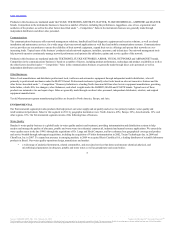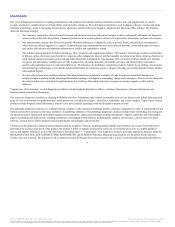Danaher 2011 Annual Report Download - page 16
Download and view the complete annual report
Please find page 16 of the 2011 Danaher annual report below. You can navigate through the pages in the report by either clicking on the pages listed below, or by using the keyword search tool below to find specific information within the annual report.
Table of Contents
For a discussion of risks related to past or future releases of, or exposures to, hazardous substances, please refer to “Item 1A. Risk Factors.”
Certain of our products are classified as medical devices under the Federal Food, Drug, and Cosmetic Act (the “FDCA”). The FDCA requires these products,
when sold in the United States, to be safe and effective for their intended use and to comply with the regulations administered by the United States Food and
Drug Administration (“FDA”). Our medical device products are also regulated by comparable agencies in non-U.S. countries where our products are sold.
The FDA’s regulatory requirements include:
• Establishment Registration. We must register with the FDA each facility where regulated products are developed or manufactured. The FDA
periodically inspects these facilities.
• Marketing Authorization. We must obtain FDA authorization to begin marketing a regulated, non-exempted product in the United States. For some
of our products, this authorization is obtained by submitting a 510(k) pre-market notification, which simply provides data on the performance of
the product to allow the FDA to determine substantial equivalence to a product already in commercial distribution in the United States. Other of
our products must go through a formal pre-market approval process which includes the performance of clinical studies and may include review of
the product by a scientific review panel.
• Quality Systems. We are required to establish a quality system that includes procedures for ensuring regulated products are developed,
manufactured and distributed in accordance with specified standards. We also must establish procedures for investigating and responding to
customer complaints regarding the performance of regulated products.
• Labeling. The labeling for the products must contain specified information. In some cases, the FDA must review and approve the labeling and any
quality assurance protocols specified in the labeling.
• Imports and Exports. The FDCA establishes requirements for importing and exporting products into and from the United States. In general, any
limitations on importing and exporting products apply only to products that have not received marketing authorization.
• Post-market Reporting. After regulated products have been distributed to customers, we may receive product complaints requiring us to investigate
and report to the FDA certain events involving the products. We also must notify the FDA when we conduct recalls or certain types of field
corrective actions involving our products.
In the European Union, a single medical device regulatory approval process exists. Regulated products must meet minimum standards of performance, safety,
and quality (known as the “essential requirements”), and then, according to their classification, comply with one or more of a selection of conformity
assessment routes. Unlike United States regulations, which require virtually all devices to undergo some level of premarket review by the FDA, the EU
regulations allow manufacturers to bring many devices to market using a process in which the manufacturer certifies that the device conforms to the essential
requirements for that device. Certain products must go through a more formal pre-market review process. We are also required to report device failures and
injuries potentially related to product use in a timely manner to the competent authorities of the European Union countries. A number of other countries,
including Australia, Brazil, Canada, China and Japan, have also adopted or are in the process of adopting standards for medical devices sold in those
countries.
We are also subject to various laws regulating (1) fraud and abuse in the healthcare industry, and (2) the privacy and security of health information, including
the United States federal regulations described below. Many states and foreign countries have also adopted laws and regulations similar to, and in some cases
more stringent than, such federal regulations.
• The Federal Anti-Kickback Statute prohibits persons from knowingly and willfully soliciting, offering, receiving or providing remuneration,
directly or indirectly, in exchange for or to induce either the referral of an individual, or the furnishing or arranging for a good or service, for
which payment may be made under a federal health care program, such as Medicare or Medicaid.
• The Health Insurance Portability and Accountability Act of 1996 (“HIPAA”) prohibits knowingly and willfully (1) executing a scheme to defraud
any health care benefit program, including private payors, or (2) falsifying, concealing or covering up a material fact or making any materially
false, fictitious or fraudulent statement in connection with the delivery of or payment for health care benefits, items or services. In addition,
HIPAA, as amended by the Health Information Technology for Economic and Clinical Health Act of 2009, also restricts the use and disclosure of
personal health information, mandates the adoption of standards relating to the privacy and security of individually identifiable health
information and requires us to report certain breaches of unsecured, individually identifiable health information.
14
Source: DANAHER CORP /DE/, 10-K, February 24, 2012 Powered by Morningstar® Document Research℠
The information contained herein may not be copied, adapted or distributed and is not warranted to be accurate, complete or timely. The user assumes all risks for any damages or losses arising from any use of this information,
except to the extent such damages or losses cannot be limited or excluded by applicable law. Past financial performance is no guarantee of future results.
























